Focusing on the backpack components of Master Grade Sinanju Ver. Ka in this batch of work, after the previous posting. ^^
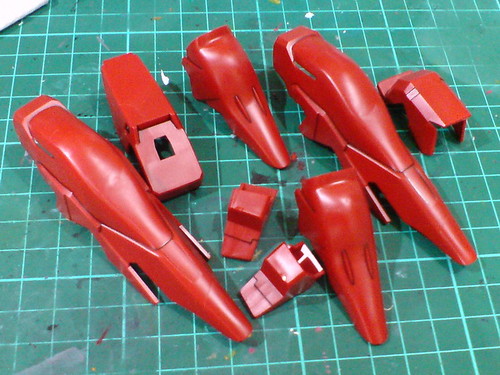
Simple panel lining for the armor parts of the wing binders and backpack.
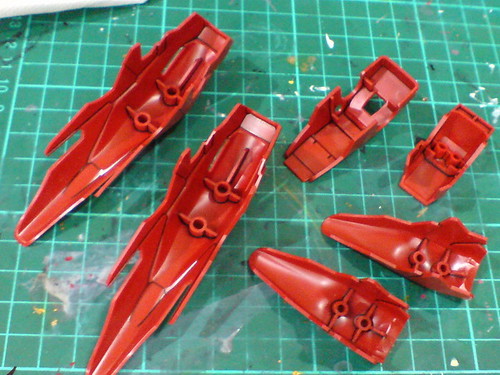
Much like the leg armors (Part 15), the molded details beneath the wing binder and backpack armor parts are panel lined, using a combination of normal panel liner, and Tamiya's Panel Line Accent Color (Black) to make sure every, and all details that might be exposed when the components are assembled have been highlighted. ^^
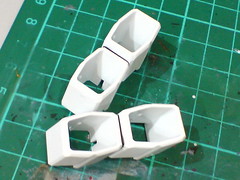
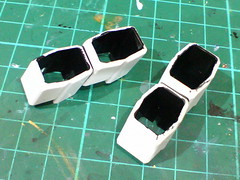
The interior of the thruster caps are painted black using Gaia Color 022 Semi Gloss Black to give the components a greater sense of depth.
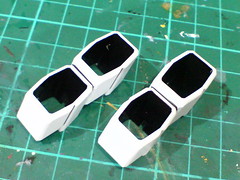
Excessive black paint on the edges of the parts is scratched away using a knife.
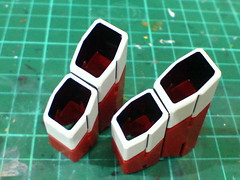
Test fitting the painted parts to see how the thruster holders would turn out when assembled. ^^
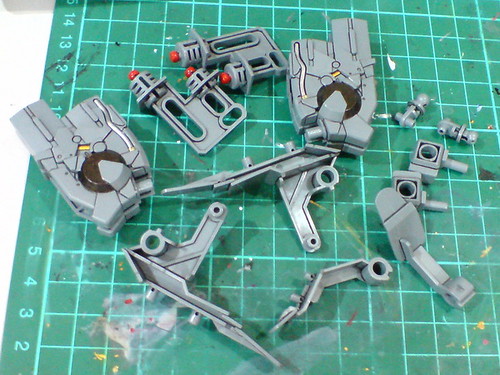
Much like the inner frame parts of the feet (Part 16), the molded details on the wing binder and backpack frame parts are panel lined, using a combination of normal panel liner, and Tamiya's Panel Line Accent Color (Black) to ensure all the details are highlighted, and can be seen on the full inner frame assembly of the model. ^^
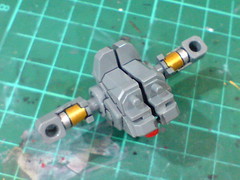
Test fitting the touched up wing binder connectors on the backpack frame parts to see how that component would turn out when assembled. ^^

The cylindrical base of the connectors on the two backpack parts is painted gun metal (using Gaia Metallic Color No. 020 Gun Metal) to give them a special look. ^^

The border between the left and right backpack parts is painted black using normal black marker to highlight the gap.


Following the component's color on the HGUC version, the vents near the tips of the propellant tanks are painted gray using Gaia Color 073 Neutral Gray III.

The vents are panel lined using normal panel liner. Their interior are painted black using normal marker. The ring of border beneath the vents is painted black to highlight the gap between the cylinders and their bottom caps when the tanks are assembled later on.
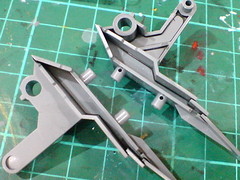
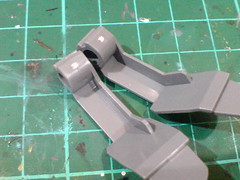
The lack of details on the top and bottom wing binder frame parts is very underwhelming, especially when compared to the elaborately painted and details body parts of the thrusters. ^^;
To not complicate the work too much, the blank interior of the top binder (left image), and empty "tray" area on the bottom binder are the identified spots for some additional detailing to be applied.
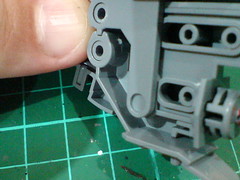
Test fitting the thruster parts to find out the exact tolerable space for additional details to be added to the bottom binder.


Checking out the fun little linked movement gimmick of the thruster binders. ^^
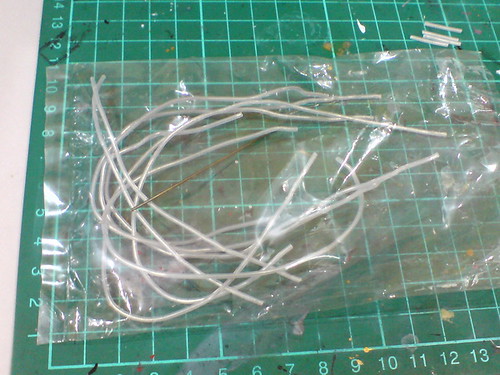
Extra materials that can be used for the binders' detailing: wired strings that were previously used to bind Transformers figures to trays inside their boxes.
These are from Transformers Movie 2 Leader Class Optimus Prime, which were previously featured in the work on HGUC Sazabi. ^^

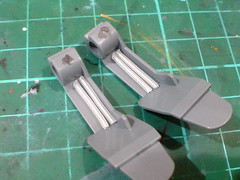
The wired strings are cut according to the length of the bottom binder's blank spot.
The strings will form a set of fixed hydraulic pipes on the parts, which wouldn't be seen unless the binders are fully expanded. The look of the crude cut near the swivel joint may be omitted, since that particular area is going to be completely hidden when the parts are assembled later on, but the pipe edges near the bottom will require extra treatment as they are going to be visible.
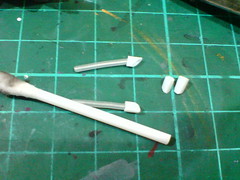
Hydraulic pipes obviously have connecting hoses, which are larger than the pipes themselves. ^^
The hoses are made from used cotton swab stick, with their bottom ends cut in an angled fashion to facilitate connection to the wing binder's surface.
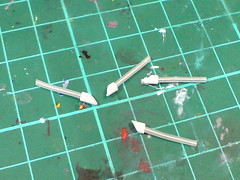
The hose pieces are secured to the pipes using a bit of superglue.
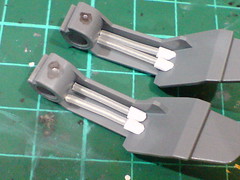
Test fitting the pipes on the targeted blank spots of the bottom binder.
The upper ends of the pipes are cut accordingly to offset the pipes' increased length after the hoses are connected to them.
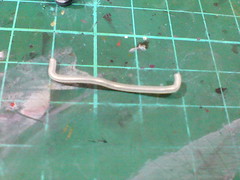
The top binders will also be given additional pipe details, made from the same wired strings shown above.
However, the work involved would be significantly easier as compared to the fixed hydraulic pipes, as it only involves bending the strings to occupy the blank spots on four sides of the binders, with a shared, consistent shape for all of them.
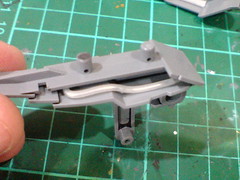
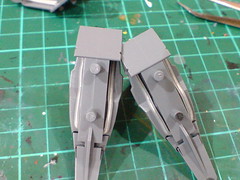
(Left) Test fitting one particular bent pipe inside the binder's hollow slot, with further tweaking on it to make sure it adheres to the shape.
(Right) The pipes are also made sure to look consistent when viewed from above. This involves pushing the strings further inwards towards the hollow spots they are facing.
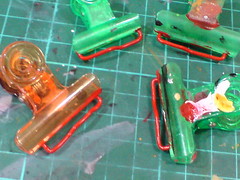
Once their designated shapes are confirmed, the pipes are removed, then painted red using Gaia Color No. 003 Bright Red Gloss.
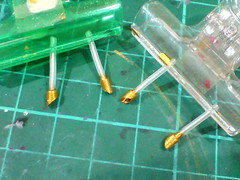
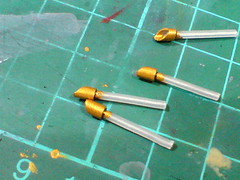
(Left) The paint work on the fixed hydraulic pipes is a little bit more troublesome: ^^; the hose pieces are painted gold using Gaia Metallic Color No. 122 Star Bright Gold first.
(Right) When the paint has dried, the border between the hoses and tubes are panel lined.
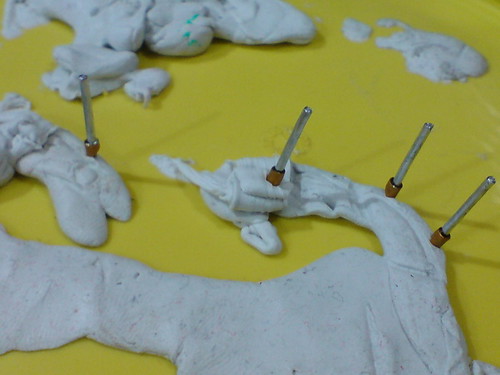
The pipes themselves are then painted silver using Tamiya Enamel Paint X-11 Chrome Silver.
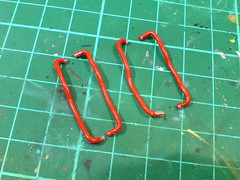
The painted pipes for the top binders.
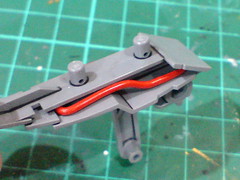
With a bit of superglue on the tip at the wider opening to secure the connection, the pipe is slid into the hollow spots one by one.
The first pipe was assembled upside-down, as you can see from the image above. ^^; I didn't want to remove the pipe anymore since it's very tightly attached to the binder part when I realize the mistake. ^^; As a result, all the pipes are assembled upside-down to maintain the consistent (but obviously wrong XD) image of the newly added details. ^^;
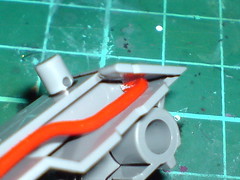
The mildly seeable spot where the superglue is applied.

Top view of the binder parts.
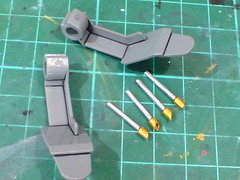
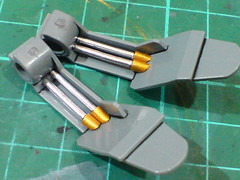
The hydraulic pipe sets are secured to the bottom binders, using superglue for their attachment as well. ^^
I suppose ordinary electrical wires can be used to achieve the pipe details for the wing binder parts shown above, especially the ones for the top binders. However, the wired strings I used for the work seems to be tougher - easily bendable, but are also able to retain their adjusted shape better after the work. Furthermore, they are readily available among the hobby materials that I have in my collection, making them the obvious choice to realize the extra details I have in mind for the wing binder parts.
Only parts for the body and head remain now for this Master Grade kit. ^^




No comments:
Post a Comment